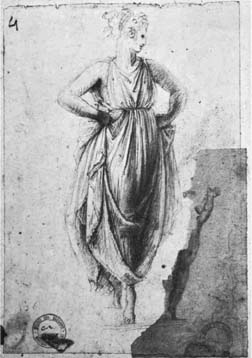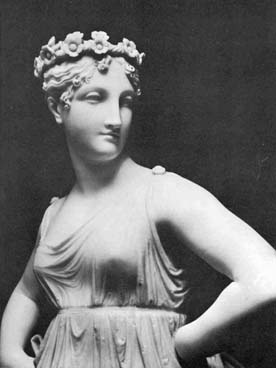
Bulletin 11 (VI:1), 1968
Home
Français
Introduction
History
Annual Index
Author &
Subject
Credits
Contact




Canova's
Statue of a Dancer
by Hugh Honour
Pages 1
| 2 | 3
| 4
Clarke said that his dancer was a much improved "replique"
of the statue carved for Josephine. Cicognara's catalogue
describes it as a "Danzatrice, ripetizione della prima con
moite differenze, pei Sig. Simone Clarke a Londra." (30) As
Canova employed the pointed gesso modello which had served
for the first version, the variations are not immediately striking:
they are numerous but very subtle - refinements on refinements in
fact. Canova was always seeking to improve his manner of carving,
especially the rendering of hair and drapery. One is reminded of
Luigi Zandomeneghi's account of Canova's inspecting antique statues
in the Villa Ludovisi and turning to him with tears in his eyes,
saying: "Anche io nella Tersicore, nelle Danzatrici, nell'Elena,
nella Pace, ho voluto pettinare: ma, e ho io pettinato cosi? Anche
io ne' panni ho cercato ii trattamenti diversi ...e ii ho io
ottenuti?" (31)
In order to appreciate the subtleties of Canova's statues one must
understand his working practice. This was as follows: after
beginning with drawings (fig. 5) and small clay bozzetti he
gradually proceeded to the creation of a clay modello as
large as the final statue.
This was finished with great precision and a plaster cast taken of
it. Metal points were inserted in the cast and with these as guides
the assistants in the studio roughed out the statue from a block of
marble. Canova himself then resumed work, carving the entire surface
of the figure, often varying details, especially of hair and
drapery, and giving them a more lively articulation than in the modello.
According to Mrs. Eaton, "the last finishing touches he
generally gives by candlelight." (32) To erase the marks of the
chisel on smooth portions of the marble - notably the flesh - he
finally polished the surface with pumice stone. The extent of his
work on the marble naturally varied from statue to statue. But it is
significant that after his death not one of his assistants proved
himself capable of achieving the astonishing effects of texture
which distinguish all his authentic works and must therefore be
ascribed to his hand alone.
Comparison between the National Gallery of Canada's statue (fig. 6)
and the Dancer in the Hermitage (fig. 7) reveals that many
minor
adjustments were made to the folds of the dress, which is rendered
in a slightly smoother manner. But the most obvious difference is in
the treatment of the face, which is altogether more lively. The
locks of hair on the forehead are a little simpler and flatter, the
eyelids are much less prominent, the cheeks are leaner, the nose is
sharper, the lips are less sensuous and wider apart. It almost seems
as if Canova had wished to transform the sultry - and perhaps rather
sulky-figure he had, not inappropriately, carved for Josephine, into
his idea of a fresh English beauty. The face of the second version
certainly has a vivacity better fitted to the elegant sprightliness
of the pose.
The figure was reproduced so frequently in the nineteenth century
and has become so familiar that one tends to overlook the striking
originality of the composition. (33) As we have already seen, the
statue was conceived quite simply as a dancer, and Canova was
reluctant to dignify her with a classical name. This is very
significant. When he had first settled in Rome in 1780, abandoning
the naturalistic rococo style of his early youth for the
neo-classical
, he soon won the title of the "continuer of the Antique."
Like all great neo-classical artists he sought, not to copy antique
statues, but to learn from them, to work in their spirit and perhaps
excel them. In a number of statues he measured himself against the
creators of the antique marbles, which were then the most highly
regarded works of art in Europe. In carving the two boxers, Creugas
and Damoxemus, he attempted to realise an antique group known only
from a description by Pausanias. His Perseus and his Venere
Italica were executed as substitutes for the Apollo, Belvedere
and the Medici Venus taken to Paris by Napoleon. To the
more hidebound the carving of these figures smacked of hubris. But
Canova seems to have had no fear of divine retribution. In his Hercules
and Lichas he attempted to go one better than the author of the Farnese
Hercules by showing the gigantic muscular figure sprung into
violent action.
There were, of course, a few hostile critics who regarded Canova as
no more than a pasticheur. But, as Ouatremère de Ouincy
remarked at the end of a passage in which he drew the usual
neo-classical distinction between the copy and the imitation, "Nous
croyons, qu'entre les ouvrages de Canova....on auroit quelque peine
à en trouver un dont le sujet, dont l'idée, dont la composition,
dont le caractère et l'ensemble puissent paroître, non pas une
redite formelle, mais même (excepté peut-être le Persée) une
approximation sensible d'une figure antique...." (34) In carving
his Dancer - or rather, his three dancers, one with her hands on
her hips, one with her finger on her chin, the third flourishing
cymbals above her head (35) - he produced statues which had no
precedent in antiquity. To quote Ouatremère again, "en
parcourant la suite de ses trois Danseuses, on est forcé de reconnoître
que Canova ne trouva dans aucune statue antique, aucun antécédent,
à quoi pouvoir s'assimiler. Effectivement, nous ne connoissons de
Danseuses représentées par la sculpture des anciens, qu'en petites
figures de bas-relief, ou bien, si l'on veut, quelques Bacchantes,
qui, sur des vases ou des frises, sont vues dans des attitudes plus
appropriées à la course qu'à la danse."
But if Canova had been motivated partly by a desire to outdo
antiquity, and perhaps to silence those who accused him of being a
copyist, he must also have been inspired by his lifelong interest in
the theatre. The diary which he kept in 1779 and 1780, on his first
visit to Rome and Naples, reveals him as an appreciative spectator
of the ballet. In Rome, for instance, he saw Cimarosa's Tito
Manlio and
noted the names of the principal dancers, Onorato Vigano and Giacomo
Tantin (the latter in a female role); in Naples he saw at the San
Carlo theatre "due bellissimi balli di Monsieur Piche, uno
rappresentava il ratto delle Sabine, e l'altro era un balo di mazzo
carattere." (36) The dance theme first appears in his work in a
low relief of The Dance of the Sons of Alcinous modelled
between 1783 and 1790. (37) In 1795 he began a statue of Hebe in
a dancing posture. (38) Numerous dancers appear in a series of
gouache paintings which he probably executed at Possagno after he
had fled from Revolutionary Rome in 1798. At about the time when he
was beginning work on the dancer for Josephine he modelled a relief
of the Dance of the Three Graces. (39) And at Bassano there is
a witty self-portrait drawing which shows Canova seated with pencil
and sketch-book while a ballerina prances beside him (fig. 8). (40)
It is not possible to say how far these works were inspired by
dancers he had actually seen in the theatre. But Canova's statues
may have had some influence on the ballet. Three poems in
praise of a ballerina performing in Venice in 1815 are illustrated
with engravings of Canova's dancer with her hands on her hips,
the dancer with her finger on her chin, and the sons of Alcinous. (41)
Next Page | Notes
1
| 2 | 3
| 4
Annual Index | Author & Subject | Credits | Contact
This digital collection
was produced under contract to Canada's Digital Collections program,
Industry Canada.
"Digital
Collections Program, Copyright
© National Gallery of
Canada 2001"